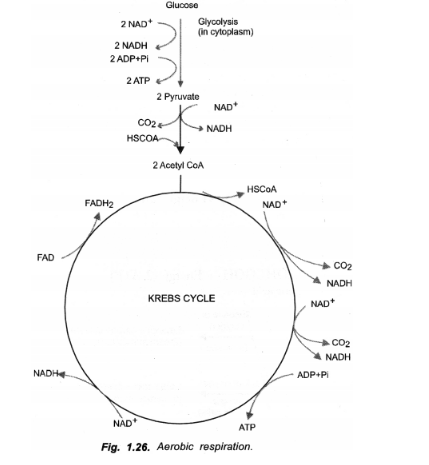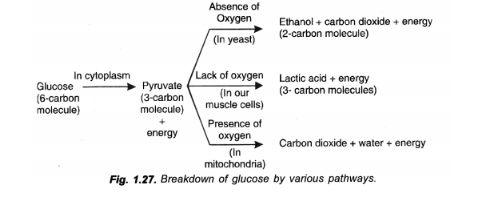Explain the three pathways of breakdown (respiration) in living organisms.
(i) Aerobic Respiration:
It is a multistep complete oxidative breakdown of respiratory substrate into carbon dioxide and water with the help of oxygen acting as a terminal oxidant. Aerobic respiration is the usual mode of respiration in all higher organisms and most of the lower organisms. The reason is that it yields maximum amount of energy. The energy is stored in some 38 molecules of ATP.

Aerobic respiration occurs in two steps, glycolysis and Krebs cycle.
$\mathrm{C}_{6} \mathrm{H}_{12} \mathrm{O}_{6}+6 \mathrm{O}_{2} \stackrel{\text { enzymes }}{\longrightarrow} 6 \mathrm{CO}_{2}+6 \mathrm{H}_{2} \mathrm{O}$ $+686 \mathrm{kcal}$ or $2870 \mathrm{~kJ}$
Glycolysis: Glycolysis or EMP (Embden, Meyerhof and Parnas) pathway is the first step of respiration which is common to both aerobic and anaerobic modes of respiration. It occurs in cytoplasm. Respiratory substrate is double phosphorylated before it undergoes lysis to produce 3-carbon compound, glyceraldehyde phosphate. NADH2 and ATP are produced when glyceraldehyde is changed to pyruvate. The net reaction of glycolysis is :

Krebs Cycle (Krebs, 1940): It is also known as citric acid cycle or tricarboxylic acid cycle (TCA cycle). Pyruvic acid or pyruvate passes into mitochondria. It undergoes oxidative decarboxylation to produce acetyl CoA, carbon dioxide and NADH2. Acetyl CoA enters Krebs cycle. Here two decarboxylations, four dehydrogenations and one phosphorylation or ATP synthesis occur.

NADH2 and FADH2 liberate electrons and hydrogen ions. They are used in building up ATP molecules and activating oxygen molecules to combine with hydrogen for forming water. Synthesis of ATP from ADP and inorganic phosphate with the help of electron generated energy during oxidation of reduced coenzymes (NADH2, FADH2) is called oxidative phosphorylation. Water formed in respiration is called metabolic water. As oxygen is used at the end of Krebs cycle for combining with hydrogen, the process is called terminal oxidation.
The overall equation of aerobic respiration using glucose as substrate is

(ii) Anaerobic Respiration Producing Alcohol:
It is a multistep breakdown of respiratory substrate in which atleast one end product is organic and which does not employ oxygen as an oxidant. Anaerobic respiration occurs in many lower organisms, e.g., certain bacteria, yeast. In human body it occurs regularly in red blood cells and during heavy exercise in muscles (striated muscles). Anaerobic respiration occurs entirely in the cytoplasm. It has two steps. The first step is glycolysis. Here, respiratory substrate glucose breaks down into two molecules each of pyruvate, ATP and NADH2. Pyruvate is converted into ethyl alcohol (C2H5OH) in Yeast and certain bacteria. It is changed to lactic acid (CH3CHOH.COOH) in muscle cells when oxygen utilisation is faster than its availability as during vigorous exercise. It creates an oxygen debt in the body. No such debt occurs in blood corpuscles.

(iii) Anaerobic Respiration Producing Lactic Acid:
Build up of lactic acid in muscles during prolonged activity causes fatigue and results in cramps.
Fermentation (L. fermentum-froth). It is anaerobic breakdown of carbohydrates by microorganisms producing alcohol, organic acids and a variety of other products alongwith heat and waste gases. Fermentation is used in brewing industry (for producing wine, whisky, beer), baking industry (for making bread spongy), curd and yoghurt formation, synthesis of vinegar, citric acid, lactic acid, softening and aromatisation of Tobacco, Tea and other beverages, cleaning of hides and separating or retting of fibres (e.g., Jute, Hemp).

Click here to get exam-ready with eSaral
For making your preparation journey smoother of JEE, NEET and Class 8 to 10, grab our app now.
